Are you ready to record your podcast and level up your web or social media content? Or perhaps you're just starting and looking to produce one independently. The first thing you'll need is a computer, a microphone, and audio editing software for recording and podcast editing.
The program we'll look into today is an excellent option for independent podcasters, but many experienced creatives use it regularly because it’s simple, intuitive, open source, and totally free. We’re talking about Audacity, one of the most well-known audio editing software for podcast editing.
Before we get into it, you’ll need to download Audacity from the official website and install it. It’s available for all major operating systems, Windows, macOS, and Linux, so that everyone can use it to edit podcasts.
This article will guide you through the entire process of using Audacity for podcast editing, so by the end of this post, you’ll have all the knowledge you need to get started right away.
Step 1: Setting Up Your Gear
The first step is to set up your audio devices. Make sure your system detects your external mic correctly, whether you’re using a USB microphone, one with a 3.5mm jack plug, or an XLR microphone plugged into an audio interface or a mixer. Then, launch Audacity.
At the top of your screen, just below the transport toolbar (where the play, pause, and stop record buttons are), you'll see the Device Toolbar with four drop-downs. We're going to select the one next to the microphone where you'll find all devices that work as an audio recording device. Choose the one you want to use by clicking on it.

Stereo or Mono?
We can select to record in mono or stereo on the dropdown next to the microphone. Most microphones record mono files; unless your podcast needs stereo recording, stick to mono. It'll make your life easier, and for a podcast, it's unlikely you'll need stereo recording.
Audio interfaces with two channels can sometimes split the microphone's inputs to the left and right channels. If you have one of these interfaces, select mono to avoid having your voice coming from one side only and ensure the mics are on the right recording channels. You can always edit the podcast episode afterward, but it's preferable to record in mono from the start.
There's a third dropdown to select your output device where you can choose your headphones, studio monitors, or your audio interface. Pick yours, and you're all set for the next step! To avoid issues, connect all your devices from step 1 before you open Audacity.
Step 2: Testing and Recording
The next step after setting up your devices is to do some tests for audio quality.
First, we need to go to the Recording Meter Toolbar and click on it to start monitoring. Speak at the same volume you usually use with your microphone. If you see a green bar moving, your microphone is set up correctly; try to stay in the green zone between -18 and –12db.

If your levels are too low or too high (red zone), we can adjust them during the podcast editing process to guarantee the best audio quality from our microphone. To do this, we're going to look for a microphone and speaker icon with a slider: the Mixer Toolbar. The mic slider adjusts the recording level and the speaker's playback volume. Play around them until it's loud enough, but it's not distorting your audio file.

Using the Transport Toolbar
To start recording, hit the red record button on the toolbar, and you'll see your recording in a waveform. Listen to it with the play button, and if you like what you hear, you can start recording your podcast episode; if something is off, continue adjusting your levels and devices.
Whenever you need to take a break from recording (to read your script, for example) and continue where you left off, press the red pause button. To completely stop the recording, press the stop button. Hit the record button again when you're ready to resume recording.

Step 3: Get to Know Your Tools
Selection Tool
The tool you'll be using the most is undoubtedly the selection tool. It will allow you to highlight segments of one track by simply clicking and dragging, similar to how you do it on any word processor. Podcast editing, deleting audio, and adding sound effects are super simple with this tool.

You can also set a playback point to listen to a selected section. Let's say you're editing something around minute 23 of a 1-hour podcast; instead of listening to the entire podcast episode, click somewhere close to minute 23 so you can hear that portion of the audio right away.
Envelope Tool
This tool is handy for podcast editing, background music, intro narration, intro music, and voice-overs. It controls the audio levels within the track.
Go to the track you want to edit.
Click on the section of the track to set a mark from where you’ll start working.
Click and drag up or down to modify levels after the mark.
You can create as many sections as needed to make the effect you want.

Zoom Tool

We can zoom in and out of the track with the zoom tool. It comes in handy when you're listening to something in your audio files that should not be there. By zooming in, you can see where that unwanted noise is coming from in the waveform. It can also help us structure podcast episodes, as by zooming in and out we get a better view of the project to ensure the intro and outro music are set to start at the right time.



Step 4: Importing Multiple Tracks
You already know how to record your voice using Audacity, which is what you’ll be doing most of the time. But what if you need to import previously recorded tracks? Or additional audio files of an interview you did outdoors or via Zoom? How about those two tracks with royalty-free music you got for your intro and outro music? Or your guest who recorded parts of their interview on a separate track?
Go to the Menu Bar.
Under the File menu, select Import.
Click Audio.
When the window pops, select the audio file you wish to import.

The audio file will show as a new track. Now, you can start editing the separate track to structure your podcast episode. This process also works with sync-locked tracks.
Look at all you've learned so far! You can now set your audio devices, make your first recordings, import tracks, and use the essential editing tools. But the fun part is about to start.
Step 5: Let’s Start Editing!
Having your podcast recorded and structured isn't enough. Don't upload and share it like that. If you listen to it now, I'm sure it doesn't sound like the podcast you hear online; that's why you need to edit your podcast before publishing it. We talked a bit about what you can do with the tools, but how do we move tracks or sections?
If you're using an earlier version of Audacity (before 3.1.0), you have the Time Shift Tool, which allows us to move the track to set it at a specific time by clicking and dragging. If you're working on version 3.1.0 or above, the Time Shift Tool is gone; by hovering your cursor right above the track, you'll see the tool change to a hand, and then we can move it.

Click and drag the selected track or section where you need it to start and release. It's pretty simple!
You can copy, cut, split, and trim sections of your track and move them to give order to the podcast episode. Highlight the area with the selection tool, go over Edit on our menu bar, and select the desired option. Try to learn the hotkeys, as this will make your podcast editing workflow smoother. Once you have all your tracks in order, we can continue with the next steps of podcast editing.
Get Rid of Background Noise
Noise reduction is a fundamental process when recording audio. Sometimes, when we record, even in a quiet environment, our microphones can pick up frequencies that cause noise. You will see this in the waveform sections where no one is talking, and there’s still something going on. We can remove background noise real quickly:
With your Selection Tool, highlight the area you want to silence.
Go to Edit in our menu bar.
Select Remove Special, and then Silence Audio.
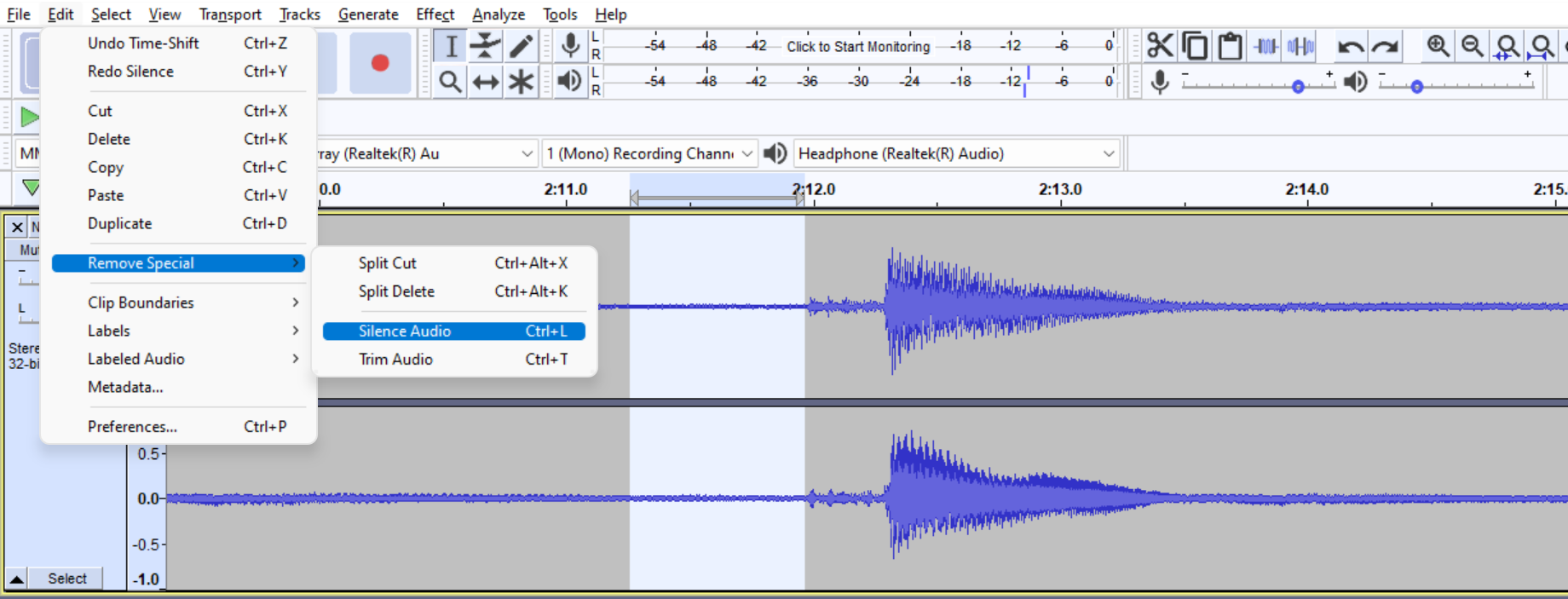
You can do this noise reduction process throughout the episode to remove unwanted noises and filler words. Remember to use your Zoom Tool to search specific parts in detail. After some noise reduction, you should have your podcast ready to add some effects.
Effects
Audacity comes with plenty of effects to edit audio tracks. Some are necessary to achieve the standard sound quality of podcasting, and others are there to add that finishing touch that will make your show stand out. We’ll start with the ones you must use.
EQ
Equalization is the number one effect you need to apply to edit your podcast. It will add so much richness to your audio, even if your microphone is not professional. By boosting or decreasing frequencies, you can significantly improve the tone of your voice.
Benefits of EQ
Eliminate sounds that are not your voice from the recording (low or high-pitched sounds).
Reduce sibilant sounds (the sounds of spoken s, z, sh, and zh).
Reduce plosive sounds (the sounds of spoken p, t, k, b).
Add clarity to our voices.
To add EQ, follow these steps:
Select the audio track you’re working on (select the entire track).
Go to Effects on the menu bar.
You'll see Filter Curve EQ and Graphic EQ; they do pretty much the same. If you're not familiar with equalization, choose Graphic EQ.
You will see a graphic and slider forming a flat line (if not, click on flatten). The numbers at the top are frequencies, and the slides increase or decrease dB.
Modify the frequencies.
Click OK. Additionally, you can save your presets to save time for future podcast episodes.
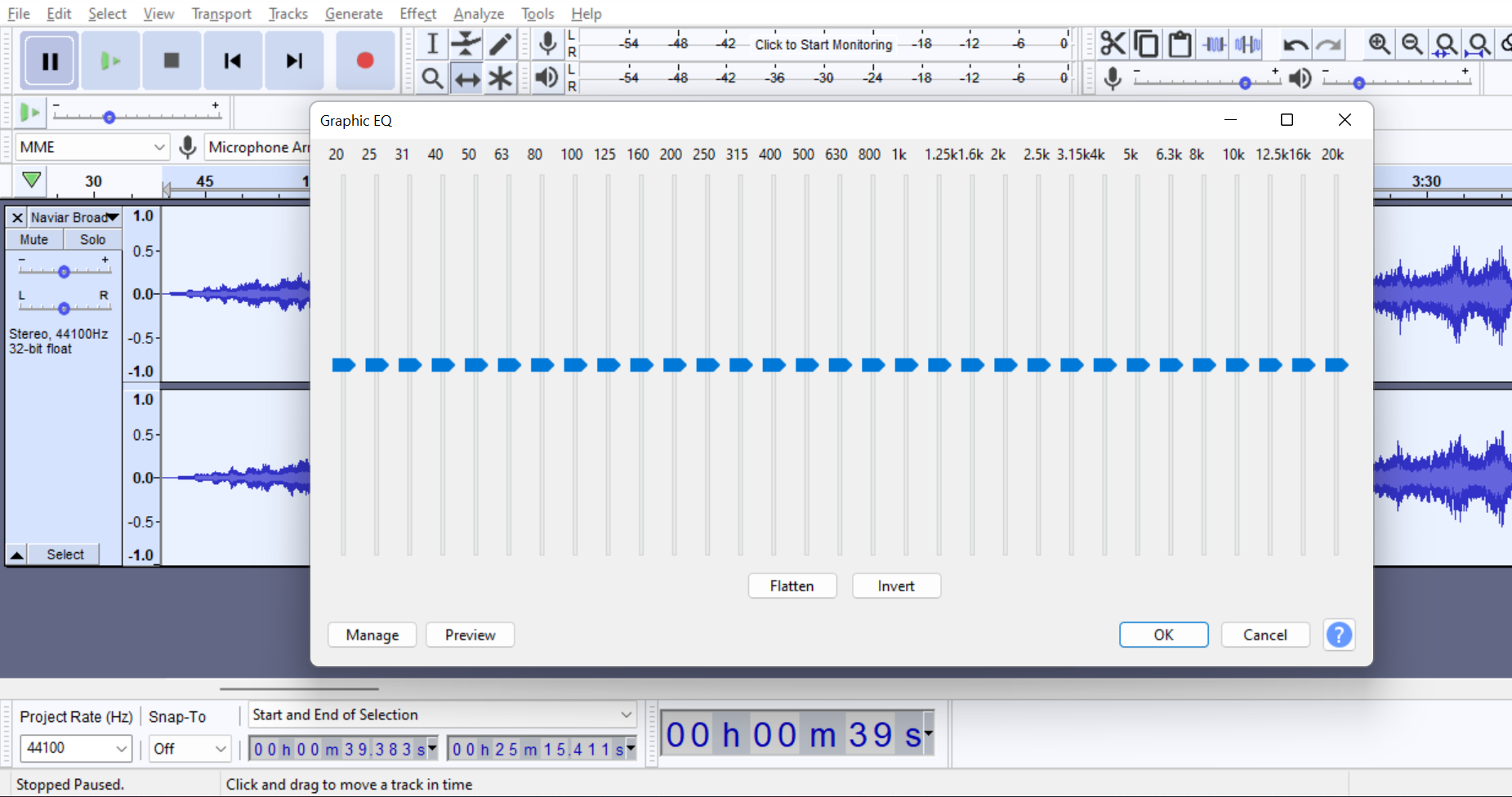
There are no universal Audacity settings for EQ, as it depends on many factors. If you're a beginner, you can start by decreasing the lowest and higher frequencies and then play around with them until you find the sound you need.
Compressor
Sometimes, you see your recorded audio present peaks in volume. This is where sections of audio are too loud or too low; adding a compressor will change the dynamic range to bring these volumes to the same level without clipping. To add a compressor:
Select the audio clip or section you want to compress with the selection tool or click select on the menu on the left of each track.
Go to the Effect menu.
Click Compressor.
Adjust the settings on the window or leave it as default (you can change those parameters once you get more familiar with it), and wait for Audacity to work.
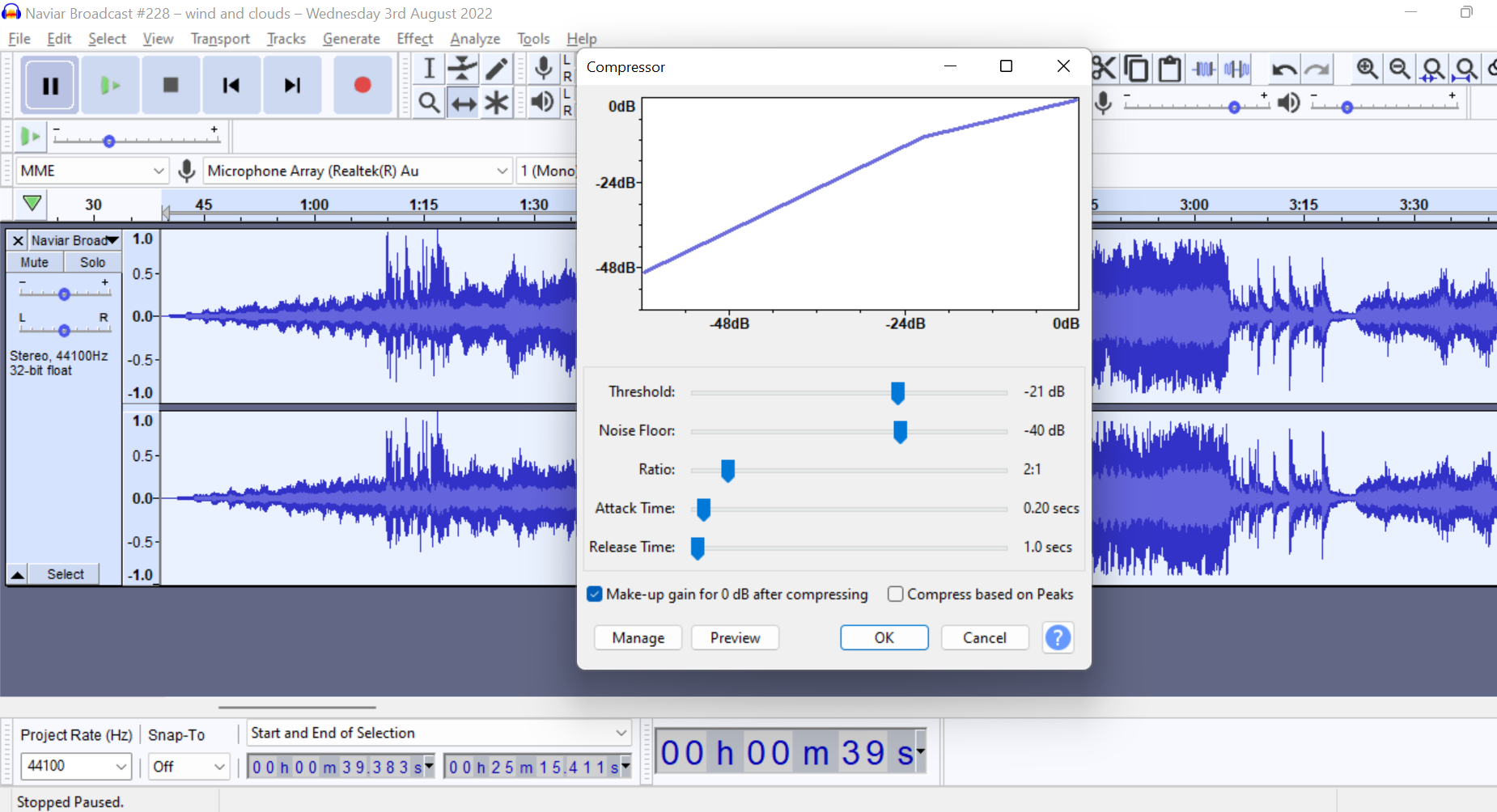
Once you're familiar with the built-in compressor, make sure you check out Chris's Dynamic Compressor, a free plug-in that can work wonders on your audio clip.
Audio Normalization
To normalize your audio means to change the overall volume of your audio clip. In Audacity, we can do two types of normalization:
Normalize (peak normalization): adjust recording levels to their highest levels.
Loudness normalization: adjust volumes to a target level by industry standards (Spotify adjusts to -14 LUFS).
To normalize your track:
Select your track.
Under the Effect menu, choose Normalize/Loudness Normalization.
Set your target settings and click OK.
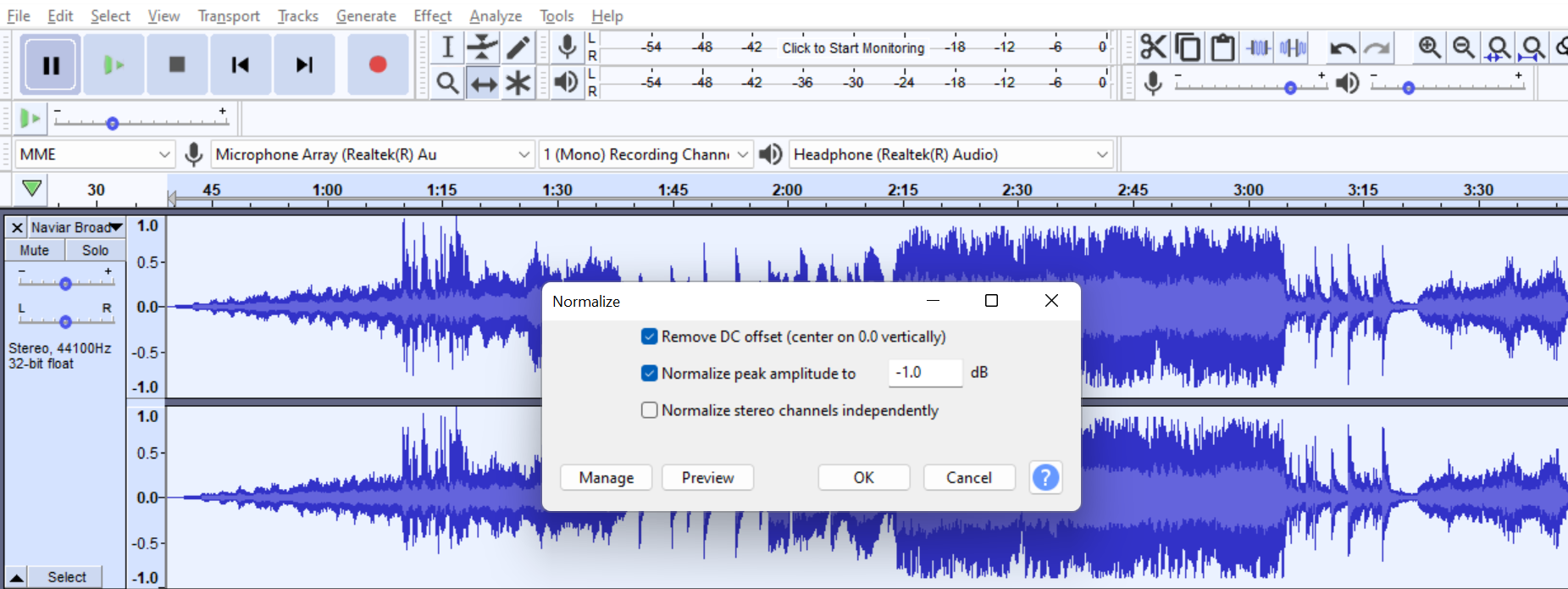
Normalization won’t affect your sound in any other way than changing your max volume levels; knowing the targeted audio level will help you set your loudness normalization to reach standard sound quality.
Amplify
Use Amplify to adjust the output volume if your recordings are too loud or too low. Make sure the “Allow clipping” box is not marked if you don't want distortion on your finished podcast.
Select a track or a track’s section.
Go to Effects > Amplify
Move the slider to increase or decrease dB.
Click OK.

Another way to adjust the volume is by using your Envelope Tool directly on the track.
If you run into distortion, Check out our post on how to fix distorted audio.
Auto Duck
Use this setting for your background, intro, and outro music. First, you must move your music on top of your voice track.
Click on the menu on the left side, drag to the top, and select the track.
Go to Effects > Auto Duck.
On the pop-up window, you can adjust the amount of dB you want to reduce when your voice starts after the intro music.
Playback to verify the volume is suitable.
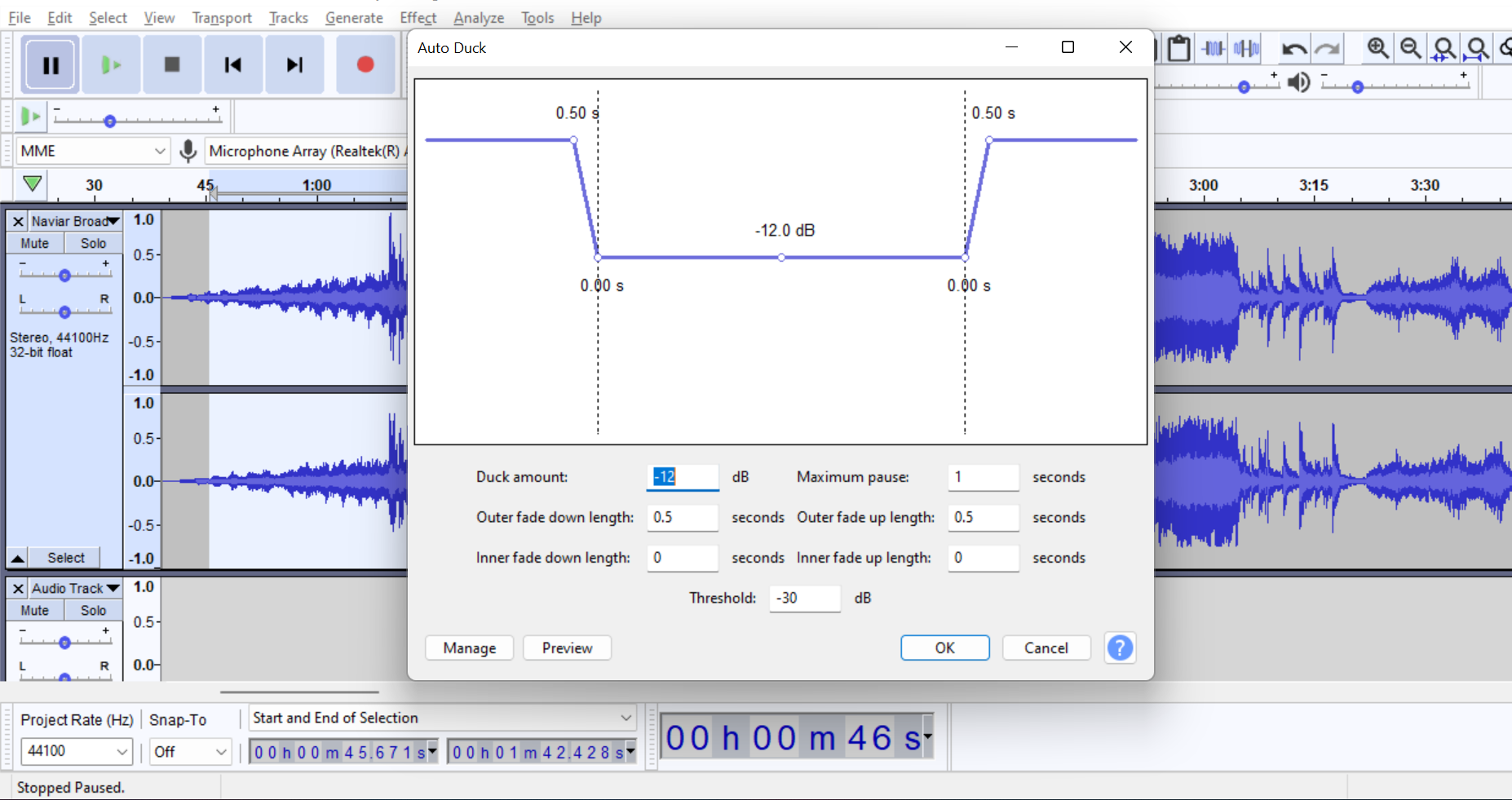
You can also do this by adding fade-ins and fade-outs effects or with your Envelope Tool, but it's much easier and time-saving using Auto Duck.
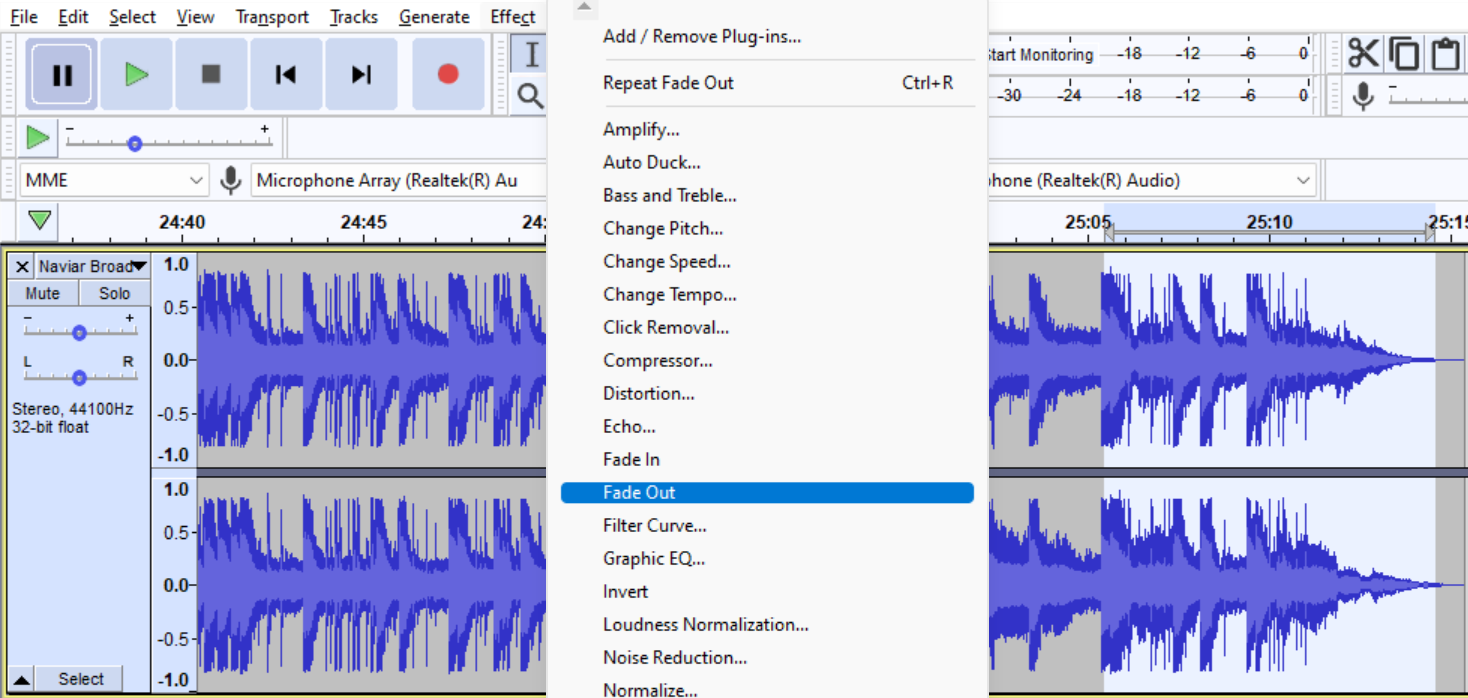
Step 6: Exporting Your Podcast
You made it! You just finished recording and podcast editing and are now ready to share it with the world via apple podcasts or your favorite podcast host. There's just one final step you need to make, which is to export it correctly.
Go to File on the menu bar.
Click Export.
Choose the audio format of your preference (I recommend exporting in WAV, MP3, M4A, or what your podcast host suggests).
Name your project and save it.
Edit the metadata (name of your podcast and episode number).
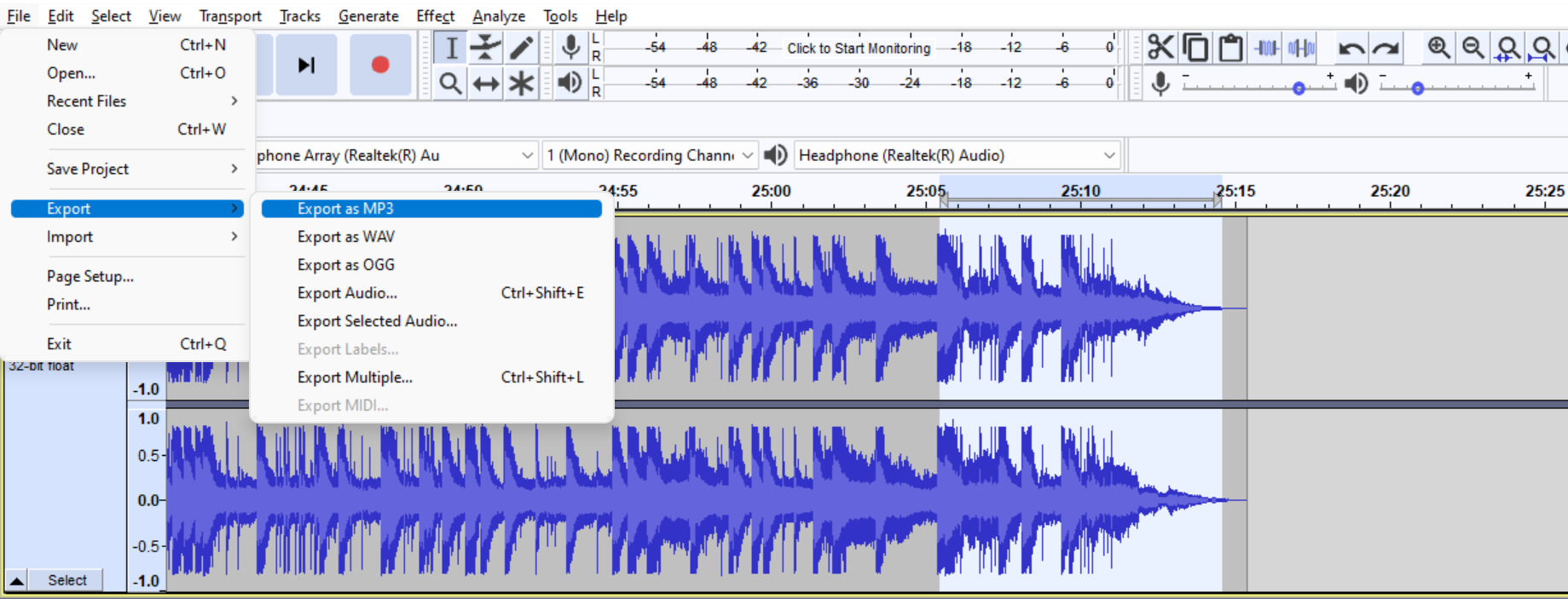
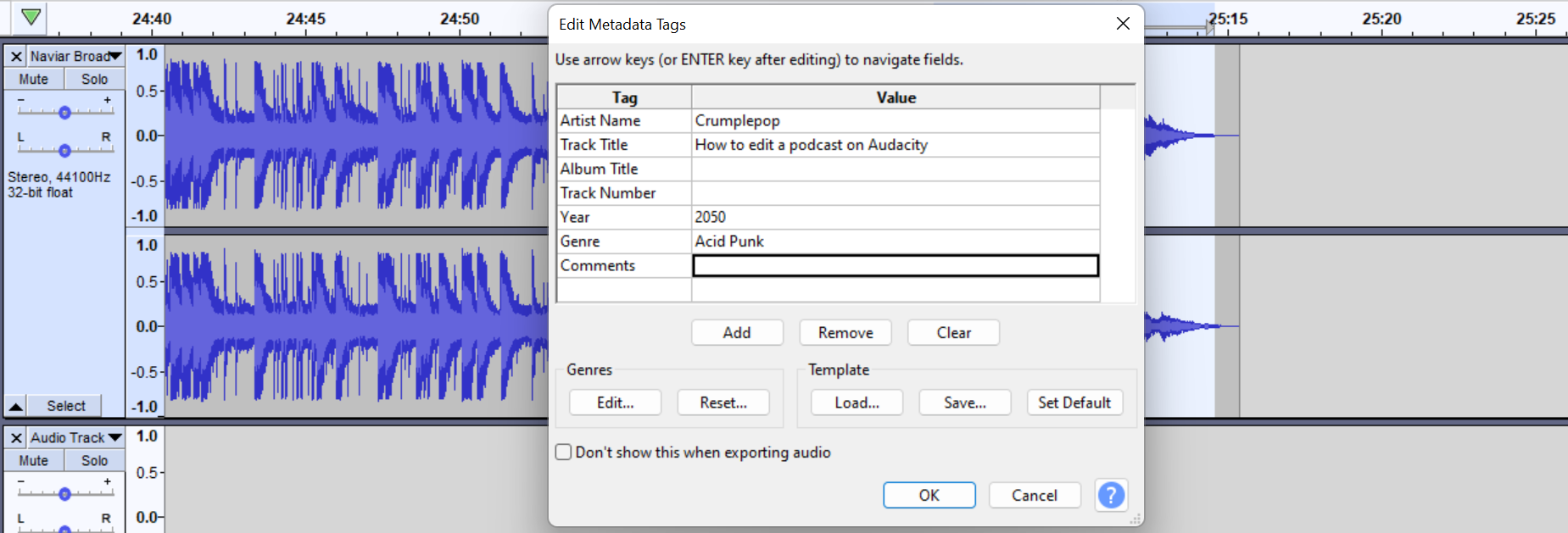
Podcast editing is possible in any operating system with open source and free audio editing software like Audacity. No need for Pro Tools or a professional Digital Audio Workstation. Keep this guide for future reference on podcast editing, and stay creative!











